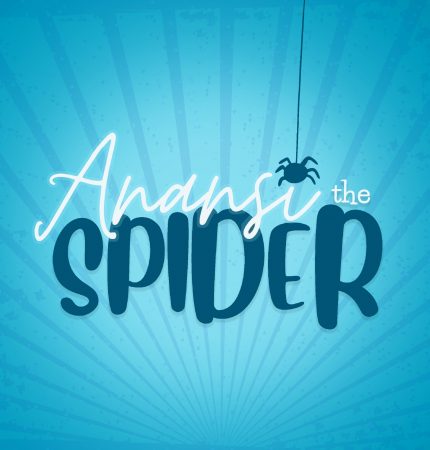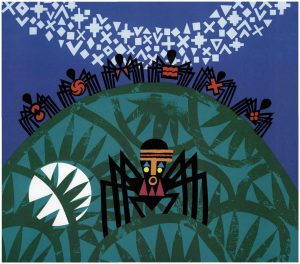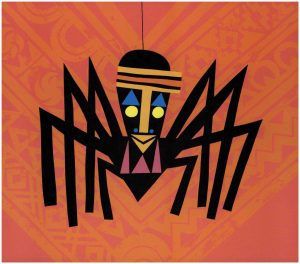Anansi the Spider Play Guide
What to know – before the show!
[bs_collapse id=”collapse_a29c-abb4″]
[bs_citem title=”Play Synopsis” id=”citem_bb26-4f68″ parent=”collapse_a29c-abb4″]
The story begins shortly after Anansi acquires the wisdom of the proverbs from Nyame, the sky god. Nyame angrily searches for Anansi to regain what he has lost; he sends the winds to discover the spider’s whereabouts, but the winds cause Anansi to drop the proverbs, scattering the wisdom.
Aso, Nyame’s daughter, tells her father to calm the winds, for the proverbs rightfully belong to Anansi. Nyame is upset and decides to rest. When Anansi meets Aso in the garden, there is an instant attraction. Anansi shares his version of how he spread the wisdom and tries to win Aso’s affections. Anansi decides his life would be great if he could marry Nyame’s daughter and sets off to win her hand. Aso and Nyame are not convinced Anansi’s intentions are pure as the spider boasts about his successes.
Aso tests Anansi’s commitment by asking him to obtain a Crocodile’s tooth, a Lion’s whisker and an Eagle’s feather. Anansi meets Marty, a crocodile with a sweet tooth, Lelia, a lion beauty queen, and Edwardo, an eagle who is scared of heights. One by one, Anansi tricks them into relinquishing the needed items. When he returns to Nyame and Aso, he lies about how he obtained the items. Aso and Nyame see right through him prompting Aso to give Anansi another chance by issuing a more complicated task.
Anansi is charged with putting stars in the sky. The task seems impossible until he meets Chloe, a smart but lonely firefly. Anansi helps Chloe find some friends who join her in lighting the heavens. When Anansi takes credit for the firefly’s feat, Aso and Nyame are greatly offended. Nyame sends the winds to dry up all the water leaving the whole earth to suffer if Anansi cannot make it rain. Anansi cannot make it rain and realizes he is doomed.
Aso takes pity upon the trickster spider and guides him through the task. Once the water is restored, a humble Anansi asks forgiveness. Nyame recognizes that he has been foolish; he punished all the creatures, not just Anansi. Anansi apologizes and asks if he can help be a caretaker, and Nyame gives him the charge of bringing the rain under Aso’s guidance.
[/bs_citem]
[bs_citem title=”Play Before the Play” id=”citem_3b2f-0bad” parent=”collapse_a29c-abb4″]
TROUBLE TRICKSTER TALES
The many misadventures of the trickster spider Anansi have been passed down from generation to generation. As each new person tells the story, they may make changes to details or put the characters through different obstacles. Now there are a wide variety of stories featuring the famous spider including LCT’s production of Anansi the Spider.
For this activity, begin by having your students read two different Anansi tales using the link below:
[bs_button size=”md” type=”primary” value=”Anansi Tales” href=”https://www.lctonstage.org/wp-content/uploads/2023/02/Anansi-Tales.pdf”]
After reading the stories, have your students compare and contrast the stories. What elements of the trickster tales were similar? Which elements were different? What were the morals of each story? Next, work with your class to create your own version of a trickster story starring Anansi the spider. Have students choose a setting, the characters, the problem and solution, and the trick Anansi plays to get what he wants. Make sure to encourage students to have a clear beginning, middle, and end to their story.
Once your story is outlined, divide your class into small groups and assign a them a scene from the class’s story. Have them work together to draw their scene. Encourage them to be as detailed as possible. When all of the images are finished, hang them up in order for everyone to see. To extend the experience, have each group bring their scene to life by acting out the events in their drawing.
KAS: VA:Cr1.2.2; VA:Cr1.2.3; RL.2.9; RL.3.9
ASSOCIATION WORD WEB
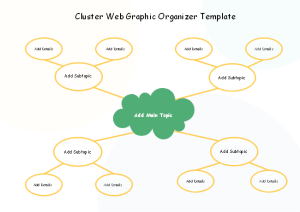
A cluster map is used to help describe concepts. A word is placed in a central bubble in the middle of a page. The initial word can be a person/character, place, object, or even a concept/idea. Then more bubbles branch off of that center bubble with words or phrases associated with the initial word/concept. For instance, the first word in the central bubble might be “dog.” From there, you might have a bubble coming off the word “dog” that says “tail.” Another bubble might say “pet.” Off of the word “pet,” you could write “cat” and “fish.” And then those words can have more words coming off of them.
Using your classroom’s white board or a large sheet of paper, start a cluster map with the word “Anansi” in the center. Ask your class to brainstorm words associated with “Anansi” to add to the map. Explain that these words can be adjectives to describe the spider, other characters that may appear in the story, locations of where a Anansi story might take place, etc. They can add words to any bubble they like. If a student gives a response that seems questionable or confusing, have them justify their association. Keep adding bubbles branching off of one another until your map is complete!
KAS: RL2.2; RL2.3; RI2.7
FOLKTALES AROUND THE WORLD
LCT’s production of Anansi the Spider is based on West African folktales starring the trickster spider. Countries and cultures all over the world have folktales of their own that are passed down from generation to generation. Begin by printing a map of the world for each of your students using the link below:

[bs_button size=”md” type=”primary” value=”World Map” href=”https://www.lctonstage.org/wp-content/uploads/2023/02/World-Map.pdf”]
Then pull up the Folktales from Around the World webpage through Google Earth. This interactive website allows you to virtually travel the globe and read about seven different folktales originating from various locations and cultures.
Start with Anansi which originated in Ghana, a nation found in West Africa. Take some time to learn a little about the Anansi folktale then work with students to learn more about Ghana as a country. Look at the landscape. Is it dry? Are there mountains? Is it near an ocean? What kinds of animals can be found in the area? Are there any particular foods or special dishes specific to the country? Discuss with your students how the geography and culture of the region might impact the story of Anansi and how those details might help to bring the story to life.
Then have students identify the general location of Ghana on their world map print out. Encourage students to draw or notate something special about the region and its folktale on their map. Continue this process for each of the remaining folktales. As students fill their map, ask them to compare and contrast the different folktales, the geographies of each region, and other details about each region’s cultures.
KAS: K.G.HE.1; K.I.CC.1; 3.G.GR.1
[/bs_citem]
[bs_citem title=”Contextual Article” id=”citem_f5e8-1164″ parent=”collapse_a29c-abb4″]
ON THE WIND: THE ORAL TRADITIONS OF THE TRICKSTER
Folktales are a subgenre of folklore. They are stories passed down from generation to generation. Long before humans could read and write, they would tell stories to entertain, express warnings, and teach future generations how to perform certain tasks. Folktales are a means of helping preserve a culture’s history, traditions, and customs so they are not forgotten over time. They are also used as a tool for teaching important morals and lessons to young people.
Anansi is one of the most important characters of West African, African American and Caribbean folklore. Most often he is shown as a spider and trickster derived from traditional Akan culture. He is usually the depiction of the consequences of your bad actions even though his stories are most based around humor.
Stories such as Anansi’s are considered to be trickster tales. A trickster is a clever animal or person who try to fool or deceive other characters. They usually play tricks so they can gain something they want without asking for it. Trickster stories usually include the trickster, a fool, comedy, a moral lesson to be learned, along with a problem and a solution.
In other African folktales, animals are used to display human characteristics. They walk and talk through their stories and even show honesty, integrity, and courage. The stories take place in climates and landscapes of particular African regions, be it the dry desert, the grassy plains, or the rainy jungle.
Like many other places in the world, there are a multitude of cultures found throughout the countries of Africa. Each of these cultures have their own set of stories that have traditionally been passed down by word of mouth. Villages might gather around a fire or in other community spaces after a long day of work, and the adults tell the children of the village stories. These stories are often meant to prepare the young people of the village for life. [/bs_citem]
How to grow – after the show!
[bs_citem title=”Extend the Experience” id=”citem_cc02-c1bb” parent=”collapse_a29c-abb4″]
SOMEONE WISE ONCE SAID…
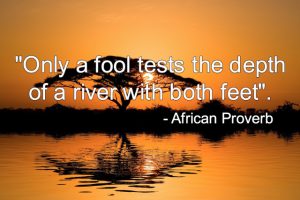
LCT’s production of Anansi began with the spider spreading the wisdom of the proverbs to the world. Help your students understand the proverbs Anansi spread with this activity.
Have students form pairs and assign each group with one of the African proverbs provided in the link below:
[bs_button size=”md” type=”primary” value=”African Proverbs” href=”https://www.lctonstage.org/wp-content/uploads/2023/02/African-Proverbs.pdf”]
Let students create either a short comic or 3-5 minute play to illustrate the proverb. Encourage students to have a clear beginning, middle, and end. Their comics or scenes should have at least two characters, a setting, a problem, and a resolution to that problem. Then have students share their creations with the class. Other students can guess the proverbs/moral of the story.
After all groups have presented their comics or scenes, discuss where proverbs come from. Ask students if they know of any American proverbs or proverbs from other cultures.
KAS: RL.3.4; VA:Cr1.2.2; TH:Cr2.1.2.a; TH:Cr2.1.2.b
RIDDLE ME THIS
Have your students write a riddle using one of the characters from the production of Anansi. You can give them the example below to help demonstrate:
Example:
I am a little girl. I wear a red cloak. I like visiting my grandmother. I know to avoid strangers. I am…
(Answer: Little Red Riding Hood)
To help your students create their riddle, they can use the following template:
I am __________ / I wear __________ / I like __________ / I know __________ / I am… _____(What’s your guess?)_____
Once students have written their riddles, have them trade with a partner to see if they can guess the character. Have students make their riddles simple at first. Then encourage students to make their riddles more eloquent by adding more descriptive words or making lines rhyme.
KAS: C.2.2.a; C.2.3.c; C.2.3.f
UNLEASH YOUR INNER ANIMAL
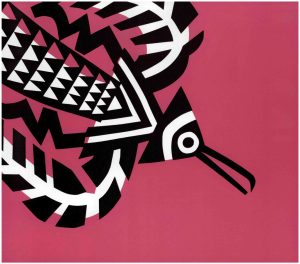
In Anansi the Spider, the actors play several animal characters. First, ask your students which animals they remember seeing in the show (Spider, Crocodile, Lion, Eagle, and Firefly). Then discuss the way in which actors can use their bodies and voices to become their characters onstage. Remember: actors are humans. They don’t walk on four legs or move like animals, so they have to find ways to suggest that they are a specific creature.
Have your students move as if they were the animals in Anansi. How can they show an eagle flying through the air or a spider meticulously spinning its web? What would a lion or a crocodile sound like? Have students take turns secretly choosing an animal to act out in front of the class. Allow their classmates to guess their chosen animal. Reflect on whether the choices they made with their bodies and voices were clear and specific to the animal chosen.
KAS: TH:Cr3.1.2.b; TH:Pr5.1.2.a; TH:Re7.1.2.
[/bs_citem]
[bs_citem title=”Suggested Reading” id=”citem_3ea5-34bf” parent=”collapse_a29c-abb4″]
If you like African folktales of wit and humor, you might also like…
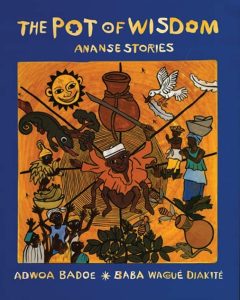
The Pot of Wisdom by Adwoa Badoe
Join Ananse, a round-bellied trickster spider, as he outwits enemies big and small in this marvelously entertaining collection of tales about one of the most popular figures in African folklore.
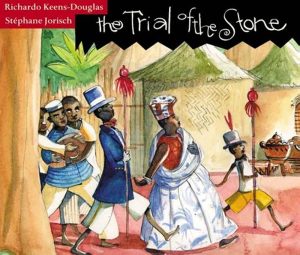
The Trial of the Stone: A Folk Tale by Richardo Keens-Douglas
When a stone is accused of a crime, the villagers at the trial must learn to take the judicial system seriously.
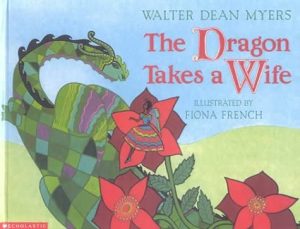
The Dragon Takes a Wife by Walter Dean Myers
When Harry the dragon is forced into fighting a knight in order to win the hand of his bride, he needs the help of a fairy named Mabel Mae Jones to give him the guidance and support he needs to get through it all.
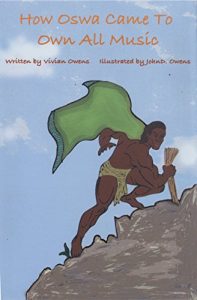
How Oswa Came to Own All Music by Vivian Owens
Oswa is a giant with a loving heart and a love of music. When Oswa requests permission to own all music that belongs to Mother Cloatee, the Queen of Land and Sea, she sends him on a series of dangerous missions to prove Oswa is worthy.
[/bs_citem]
[/bs_collapse]
Educational materials sponsored by



